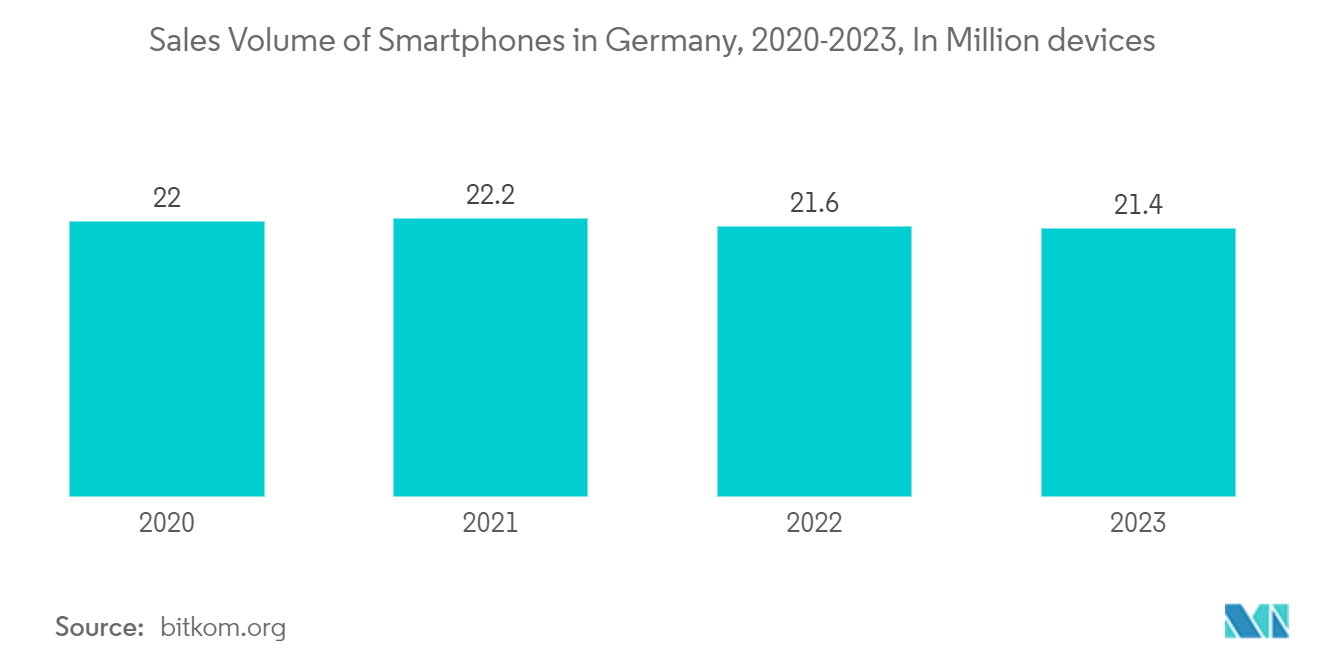Market Trends of Europe Analog IC Industry
Growing Demand for Infotainment and ADAS System in Automobiles
- The rising luxury vehicle sales and increasing customer preference for in-dash infotainment systems are driving the European analog IC market. Analog IC designed for automotive end equipment, such as infotainment systems, includes information and passenger electronics systems.
- The evolution of analog ICs for the automotive sector has benefitted different applications, like infotainment systems, vehicular handling and dynamics, power management, powertrains controls, safety solutions, IoT remote connected features, etc. Such features incorporate different ICs dedicated to specific functions to network among different sections of vehicular operation.
- Some other infotainment trends that drive the application of analog ICs are increased connectivity, 5G capability, OTA updates, and more AI. In terms of increased connectivity, IoT is driving connected vehicles, and the need for onboard car communication devices is growing as it allows quick access to data through smartphones.
- Automotive infotainment systems are subject to significant technological changes. With the spread of smartphones, the adoption of ADAS and self-driving technology is progressing. In particular, technology such as automobile system vehicles for passenger seats has become very familiar. As engineers develop innovative versions of in-vehicle infotainment systems, these features may contribute to the growth of the European analog IC market.
- In Europe, the automotive industry is an important part of its economy and contributes a significant amount to support economic growth. Several governments support automotive manufacturers in expanding their electric vehicle production and increasing the adoption of electric vehicles in the region. For instance, in December 2022, the UK Export Finance provided a loan of EUR 600 million to Ford to expand its electric vehicle production line and increase its electric vehicle range from two to nine models.
- Many car manufacturers in Europe, such as Nissan, BMW, Range Rover, and Audi, offer luxury comfort in their popular models, like Qashqai, X-series, Evoque, and Q-series, respectively. The premium car segment has been registering considerable sales in the region. In the United Kingdom, the best-selling cars in March 2022 were Tesla Model 3 (6,457 units), Tesla Model Y (6,464 units), Nissan Qashqai (5,401 units), Vauxhall Corsa (5,515 units), and Hyundai Tucson (4,876 units).

Germany to Register Significant Growth
- The German automotive industry has been leading technological innovations in the global automotive industry by integrating smart technologies. Hybrid and electric vehicles are expected to lead the growth of the automotive industry in the country, with companies focusing on electric vehicle technologies. This is expected to impact the growth of the analog IC market positively.
- Germany is Europe's biggest automotive market, accounting for about 25% of all passenger cars manufactured and 20% of all new registrations. The automotive industry generates 24% of the country's total revenue. German automotive manufacturing companies, such as Volkswagen, announced investments of EUR 2 billion in March 2022 to develop a new electric car plant in Germany, with the construction starting in early 2023 and production by 2026. The company is investing EUR 35 billion into the shift toward electric vehicles to become the world's largest electric carmaker by 2025.
- With the growing proliferation of IoT, the number of connected devices in Germany will likely grow significantly in the coming years. Each device will need ICs that contain embedded technology to communicate, sense, or interact with the environment. Therefore, the growth in IoT devices may increase the demand for ICs, thus driving the market during the forecast period. Analog ICs have efficient power consumption features and signal processing capabilities to configure an automated devices ecosystem.
- Germany has a huge penetration of consumer electronic products in the majority of households. The advancing technology has led to the trend of developing smart homes and smart offices where consumer electronics products are vital parts.
- The country is putting significant resources into digitalization efforts to enable industrial sectors to benefit from the opportunities offered by Industry 4.0 technologies. Considering the use of those types of technologies and the overall level of integration of digital skills, the increased adaption of Industry 4.0 technologies, along with the deployment of connected devices, is further expected to boost analog IC sales in the country.


